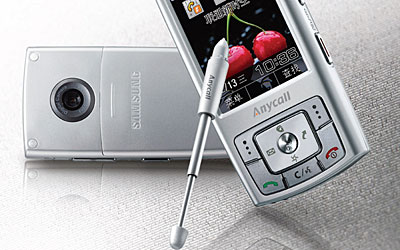
The Samsung SCH-W559 is the first touchscreen-based mobile phone to use Immersion's VibeTonz System to provide tactile feedback for touchscreen interactions.
The phone uses a large LCD touchscreen display to replace the traditional mechanical keypad as the primary input mechanism. Users receive confirming tactile cues when they press graphical onscreen controls, and they can customize the response by selecting one of five feedback profiles for these cues. The tactile feedback system allows touchscreen-displayed buttons to feel more like mechanical keys.
The new phone includes handwriting recognition, Bluetooth, a 1.3 megapixel camera, and audio and video playback functions. Vibe-enhanced ringtones enable personalization and can help identify callers in noisy environments.
"Implementing keypad functions in a touchscreen has allowed Samsung to give its customers a first-class multimedia and messaging experience in a remarkably light and slim handset," said Hunbae Kim of Samsung. "As the first to integrate VibeTonz technology for touchscreens, we're giving users the reassuring sense of interacting with a real keypad, supplying gentle touch feedback that unmistakably confirms each of their actions. As far as advanced mobile interfaces go, it offers the best of both worlds."
Mobile games are more fun and exciting with touch feedback similar to that found in console games. Tactile cues for user interface features, like call dropped, key press, and ringing and busy signals can make phone operation easier and more intuitive. Vibe tones effects accompanying ringtones or music are like turning up the subwoofers.